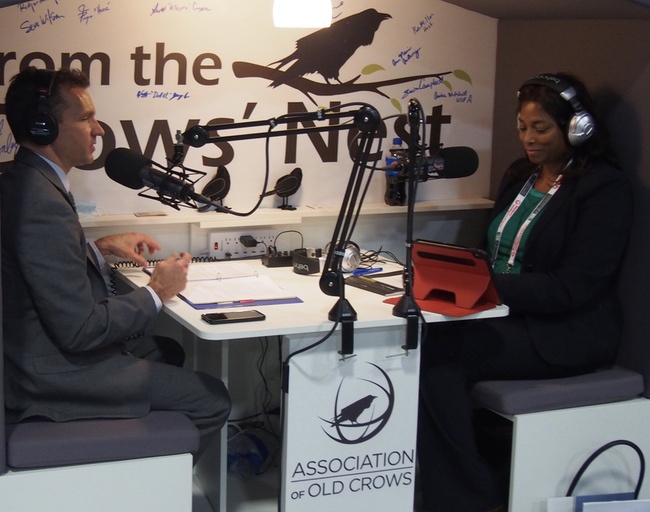After a year barrage jammed by COVID-19, the Association of Old Crows (AOC) International Symposium & Convention returned to its crows’ nest in Washington, D.C., running from 30 November through 2 December. As with past events, attendees found three full days of presentations, meetings and company exhibits, while maintaining a healthy respect for the unseen and pervasive virus. To enter, a proof of vaccination or negative COVID test was required, with masks worn throughout the event. Despite the pandemic, the attendees traveled from 25 countries according to the AOC Show Daily.
This year’s conference focused on integrating effects across the electromagnetic spectrum, broadly known as electromagnetic spectrum operations (EMSO). Quoting the organizers, “Awareness and understanding of the electromagnetic spectrum, its properties and the need to command and control effects within it are necessary to fully strategize, plan and decisively execute any mission, anywhere in the world.”
SOSA, the Sensor Open Systems Architecture, was another theme prevalent at AOC. The SOSA Consortium’s vision is moving sensor systems from program and proprietary architectures to a system built on a modular approach and open standards for the system interfaces, standards established through industry and government collaboration. At the last international AOC conference two years ago, SOSA was being organized, members recruited and its roadmap defined. This year, the SOSA Consortium reported considerable progress toward its goals, releasing the SOSA Technical Standard 1.0. A meeting at AOC highlighted the accomplishments and outlined plans for the coming year (briefings here), including an interoperability demo planned for March 2022. Many of the exhibiting companies reflected this progress by offering products designed to support SOSA.
Heidi Shyu, the Under Secretary of Defense for Research and Engineering, kicked off the conference on Tuesday, 30 November. Shu’s office focuses on moving innovative solutions from prototyping to “programs of record” within the Department of Defense (DoD).
Kelly Fletcher, a member of the DoD’s Senior Executive Service, who is performing the duties of the chief information officer of the department, provided Wednesday’s keynote. She told the conference the responsibility for maintaining electromagnetic superiority requires a national approach.
“What really makes me concerned most, frankly, is that there are probably vulnerabilities that we don't know about and that our adversaries are trying to find,” Fletcher said.
Lt. Gen. Clinton Hinote, Deputy Chief of Staff for Strategy, Integration and Requirements for the U.S. Air Force, gave the keynote on Thursday, the last day of AOC. A panel discussion following the keynote addressed the beneficial use cases and associated risks of 5G as it is adopted by militaries and governments.
Exhibition
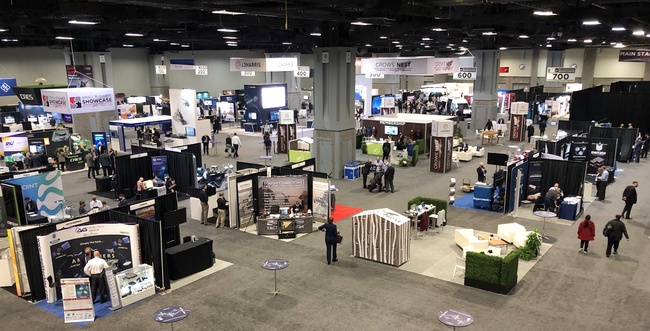
Almost 110 companies exhibited this year, counting a few formerly independent companies that have been acquired by larger firms — Mercury and Atlanta Micro and CAES and Colorado Engineering, for example. As expected at an electronic warfare (EW) conference, most of the exhibitors support the RF signal chain, somewhere along the chain from component to system, which makes AOC one of top conferences for Microwave Journal to sample the activities and health of the RF/microwave industry.
Here’s a brief summary of what we saw, including a photo gallery (masks were off only briefly while taking the photos).
AmpliTech representatives discussed the company’s custom RF components for military, space, satellite communications and communications. These products include power dividers, waveguide to coax adapters and a wide portfolio of amplifiers: low noise, cryogenic, limiting and medium to high power. The products span frequency bands from 50 kHz to 44 GHz and, depending on the model, are available with waveguide, coax or surface-mount packaging. In November, AmpliTech said it is acquiring Spectrum Semiconductor Materials, a specialty distributor of semiconductor components based in San Jose, Calif. AmpliTech says the addition will more than triple its revenue and will provide a distribution channel for its new line of MMIC amplifiers, which it expects to release by the end of March 2022.
Other than the defense primes, Analog Devices (ADI) arguably offers the broadest set of capabilities for EW systems: RF, power conditioning and data converter ICs through integrated subsystems. Among the products ADI featured at AOC was Helios, a 2 to 18 GHz frequency converter with one transmit and four receive channels that is integrated in a hermetic, single-slot 3U VPX compliant with VITA67.3. The converter has an IF of 4.5 GHz, an instantaneous bandwidth of 1 GHz for each channel and is controlled through an API, which simplifies system integration.
Sadashiv Phadnis, Anritsu’s product marketing manager for the company’s new Rubidium signal sources, demonstrated the performance of the instruments, which use the atomic frequency standard to provide an order-of-magnitude improvement in stability compared to an oven-controlled crystal oscillator. The two Rubidium models, which were announced in mid-November, have 20 or 43.5 GHz upper frequency ranges with very low phase noise and spurs. The best phase noise option achieves −140 dBc/Hz at 10 kHz offset from a 10 GHz signal, making the Rubidium well-suited for radar testing.
APITech is a broad-based supplier of RF/microwave components, integrated microwave assemblies and subsystems for military and space programs. Of interest to AOC attendees, APITech highlighted its pulsed power amplifiers (PA), designed using GaN and intended to replace TWTs. The GaN PAs provide output power to 1 kW at frequencies to 18 GHz. Within this performance envelope, GaN PAs are cost-effective replacements for TWT amplifiers, providing higher efficiency, longer lifetimes and lower size and weight. At the start of AOC, APITech announced a new CEO: Rich Sorelle is replacing Terrence Hahn. Hahn will continue on the AEA Investors' Senior Advisory Council. (AEA Investors is the primary owner of APITech.) Sorelle came from Abaco Systems, where he was CEO.
CAES and recently acquired Colorado Engineering (CEI) had two booths, yet their messaging focused on the synergistic benefits of combining CEI’s agile RF and high performance computing capabilities with CAES’ microwave module design and manufacturing. Aligned with SOSA, CAES announced a 3U up- and down-converter covering 500 MHz to 18 GHz, which the company says is the industry’s smallest single 3U up/down-converter with an integrated local oscillator and preselection covering this wide bandwidth. The two channels can be configured as a single up- and down-conversion, two up-conversions or two down-conversions.
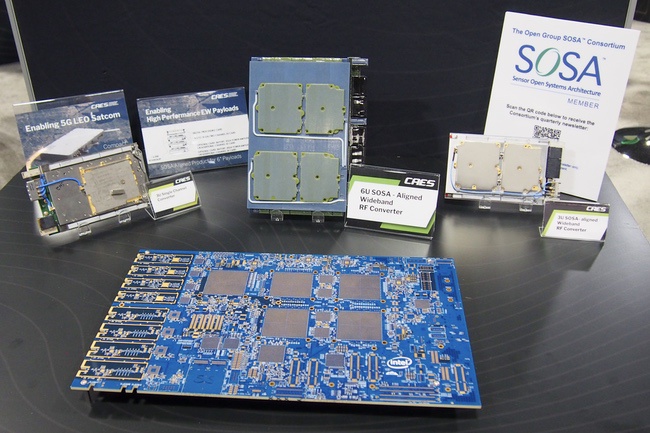
dB Control featured a new switch-based product line of custom RF/microwave components and integrated subsystems from its recent acquisition of Paciwave. The new products include an ultra-broadband switch matrix and detector log video amplifier. dB Control also promoted its portfolio of seven mmWave PAs, which were developed to address emerging threats. They cover bands from 26.5 to 40 GHz with output power from 80 to 700 W. The three higher power units are TWT designs; the others are microwave power modules, which combine solid-state with TWT.
Elite RF rose from the proverbial ashes following Motorola’s demise, recruiting the iconic company’s former talent to staff the 2014 start-up. Elite RF says its design team has some 200 years cumulative PA design experience, now applied to catalog and custom amplifier designs. Elite RF’s amplifier catalog is extensive, tapping GaN, LDMOS, MOSFET and bipolar devices to design narrowband, multi-octave and multi-decade bandwidth amplifiers to 18 GHz. Output power ranges from 1 W to more than 100 kW, and the amplifiers are packaged as connectorized modules or rack-mount units. John Mastela, VP of sales and marketing, and Ami Patel, the chief operating officer, were at AOC to discuss the company’s capabilities and identify custom opportunities.
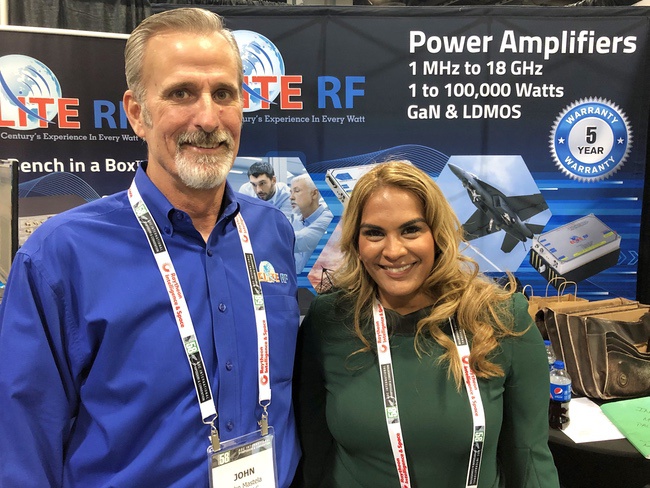
Jon Jacocks, CEO of Empower RF Systems, told Microwave Journal the company successfully pushed through the pandemic, continuing its development of “intelligent” PAs while supporting customers and booking record backlog. He attributes Empower’s success to evolving the PA from simply delivering high saturated power to handling complex waveforms. That capability has driven the architecture and complexity of the design, requiring embedded computing inside the PA. At the same time, customers are asking for higher power levels to use the capabilities of GaN, requiring Empower RF to develop innovative approaches to power combining and thermal management.
Keysight Technologies has evolved from supplying stand-alone test equipment to offering integrated systems for specific applications. EMSO is a good example, where Keysight offers equipment and software supporting the detection, identification and location of RF emitters, as well as offering scalable threat simulation and analysis. At AOC, Keysight featured a recent acquisition: SCALABLE Network Technologies, a company performing communications network simulation, modeling and cyber assessment and training. SCALABLE’s digital models of communications networks analyze and predict cyber resilience and identify vulnerabilities, a national security imperative for government and defense agencies.
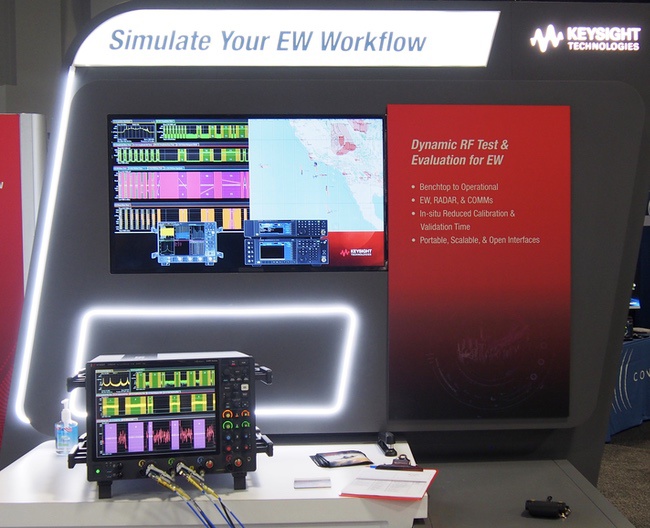
Kratos | General Microwave featured a fast synthesizer with frequency modulation, which was developed following customer requests for a cost-effective alternative to direct digital synthesizers (DDS). According to the company, a DDS costs 3x–4x more without any modulation capability. Kratos’ SM6218 covers 2 to 18 GHz and settles within 1 µs. The output frequency can be modulated ±500 MHz using either an analog or 10-bit digital word, with a maximum modulation bandwidth of 10 MHz. The unit is rugged and supports airborne applications.
The traditional companies of Microwave Products Group (MPG) — BSC Filters, Dow-Key Microwave, K&L Microwave and Pole/Zero — were exhibiting their respective filter and switch products. A newcomer to the family, the Espy Corporation, a company acquired by MPG in September, takes MPG from components to systems. Espy develops signal intelligence systems that detect, record, analyze and geolocate signals. Espy’s sensors integrate machine learning and real-time geolocation, reducing the time to identify and process signals of interest. Espy was demonstrating the TeamSentinelnano Gen 2, which includes a 1RU RF receiver covering 20 MHz to 6 GHz with a 22 MHz “stare” bandwidth.
Meggitt’s Baltimore operation discussed its experience and expertise with composite radomes and antennas for EW, SIGINT and CNI. Meggitt’s capabilities include developing and testing composite RF structures, frequency selective surfaces, conformal antennas and antenna and radome subsystems. One example: Meggitt was selected by CAES earlier this year to design and produce a radome for the Transmit Antenna Array (TAA) program. The radome will cover and protect the TAA, requiring it be rugged and low weight, yet have low transmission loss for ground-mobile EW operation.
Mercury Systems made several announcements timed with AOC: a 3U wideband microwave transceiver, a 3U VPX synchronizer and acquisition of Atlanta Micro. The transceiver (RFM3202) has two up- and down-converter channels covering 300 MHz to 18 GHz, each with 2 GHz instantaneous bandwidth. The transceiver has a built-in local oscillator (LO) or the option to use an external LO. As expected, the RFM3202 is open systems compliant. The acquisition of Atlanta Micro extends Mercury’s capabilities in MMIC design and MMIC-based modules. Mercury has been expanding its capabilities as a trusted microelectronics supplier for DoD programs, yet it lacked a strong capability to design its own RFICs. Atlanta Micro’s capabilities and experience in the DoD market help Mercury fill that gap.
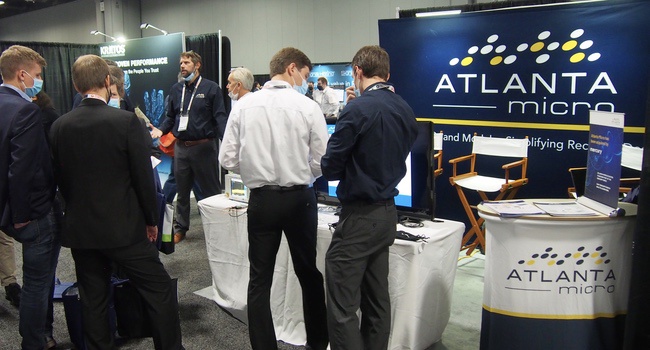
NSI-MI Technologies exhibited its capabilities in antenna measurement equipment and testing services, which span anechoic chambers, signal sources, vector field analyzers and software. The company’s target simulation systems are well-suited for EMSO, able to simulate the movement of missiles, decoys and aircraft and test the effectiveness of electronic countermeasures. NSI-MI was acquired by AMETEK earlier this year. AMETEK paid $230 million, seeing NSI-MI as a complement to its own electromagnetic compatibility test and measurement business.
RFHIC, well known for its vertically integrated portfolio of GaN devices, PAs and high power transmitters, promoted the capabilities of its GaN on SiC technology for high power military systems such as EW and radar. The company’s line of broadband amplifiers for EW covers frequency bands to 6 GHz and output power to 250 W. To enable higher output power, RFHIC is developing a GaN on diamond process. Diamond has approximately 8x higher thermal conductivity than SiC, which is the industry standard as the base wafer supporting the GaN device.
Rohde & Schwarz (R&S) was one of two companies with the largest booths at AOC (the other was BAE Systems), which reflects its long commitment to EW and SIGINT. The R&S demos included its Integrated Record, Analysis, Playback System (IRAPS). IRAPS records and stores up to 3½ hours of RF spectrum — to 90 GHz with 1 GHz instantaneous bandwidth — for playback and analysis. The system software has a “friendly” graphical interface, making analysis efficient and reducing the time to identify signals of interest. IRAPS is scalable to two RF channels for capturing signals and four channels for playback. Data from IRAPS can be used with AI and machine learning to adapt static threat libraries to reflect the evolving spectrum environment.
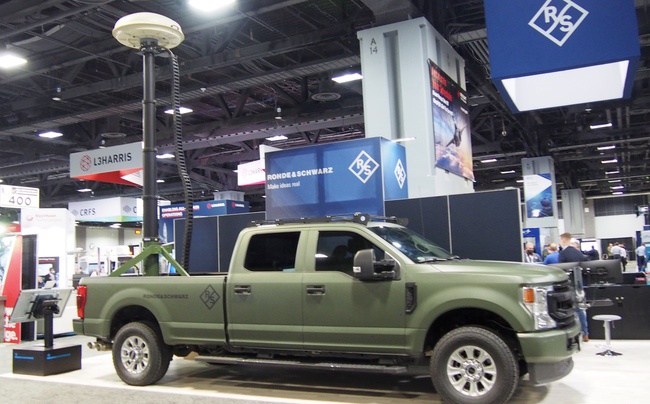
Samtec exhibited at AOC for the first time, promoting its Precision RF line of connectors, board connectors, cable assemblies and what Samtec calls RF Original Solutions for specialized applications (e.g., 75 Ω for broadcast or 100 Ω shielded twisted pair assemblies). For custom cable assemblies, Samtec offers the RF Cable Solutionator, a web application for selecting a cable type, pairing it with connectors and creating a part number — in under a minute. The application models the performance of the assembly and provides pricing and lead time. Samtec’s microwave and mmWave cable and connector choices are extensive, including 0.047 to 0.277 cables and 1.35, 1.85, 2.40 and 2.92 mm, SMA, SMPM, SMP, MCX, MMCX, BNC and high-density BNC connectors.
Signal Hound demonstrated its new SM435B mmWave spectrum analyzer and monitoring receiver, giving AOC attendees the first opportunity to see it. The SM435B tunes from 100 kHz to 43.5 GHz with 160 MHz instantaneous bandwidth and 110 dB dynamic range. The I/Q streaming bandwidth is selectable between 5 kHz and 40 MHz, and 2 s of calibrated I/Q data can be captured at full 160 MHz bandwidth. Signal processing is shared between an internal Altera FPGA and an external PC with an Intel i7 processor. Also on display at AOC: the BB60D real-time spectrum analyzer covering 9 kHz to 6 GHz, an upgrade to the C model that provides 10 dB higher dynamic range. The new version has preselector filters from 130 MHz to 6 GHz.
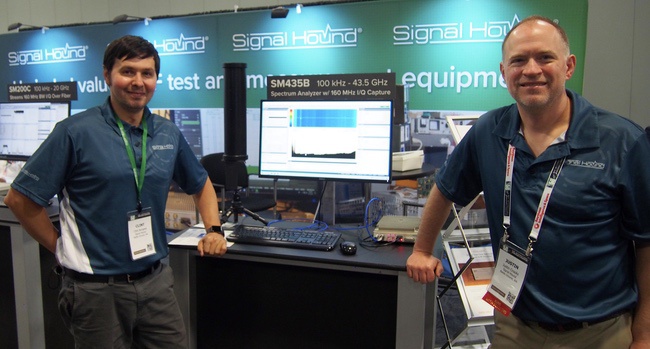
TE Connectivity was one of the companies showing its VPX interconnect products aligned with the SOSA standard. For RF connections, TE offers the VITA 67.3 NanoRF modules and contacts, which have twice the density of the VITA 67 SMPM interconnects. The contact design supports operation to 70 GHz and will interface with 0.047 and 0.086 in. semi-rigid and flexible cables.
Teledyne Defense Electronics featured a 3U VPX down-converter covering 24 to 40 GHz with 1 GHz instantaneous bandwidth and an IF range from 2 to 18 GHz. Open systems compliant and designed for airborne and shipborne deployments, Teledyne’s down-converter has 9 dB noise figure and 90 dB linear dynamic range (with a 1 MHz bandwidth). The unit has a built-in LO using a 100 MHz reference and achieves a composite phase noise of −120 dBc/Hz at 1 MHz offset.
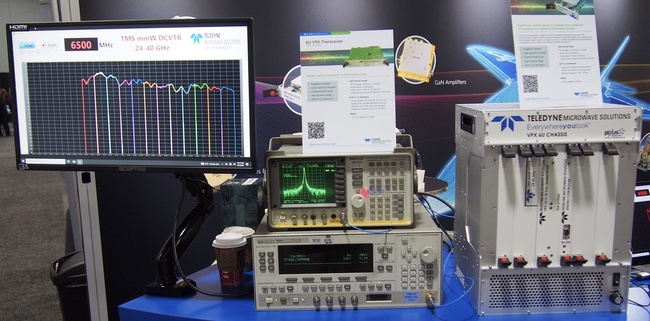
Xilinx demonstrated its Versal AI Core series, using the VC1902 device to implement a space-time adaptive processing (STAP) algorithm for radar signal processing. Where signal interference is prevalent, such as ground clutter or jamming, STAP can achieve an order-of-magnitude improvement in target detection sensitivity. Using the VK190 evaluation kit, the STAP algorithm was coded in less than six weeks, showing the utility of the evaluation kit for rapid development.
Signals Intelligence as a Service
Before concluding this summary, I want to mention one of the most interesting new ventures I’ve seen, being pursued by two companies that were exhibiting at AOC.
HawkEye 360 and Kleos Space are independent, competing companies with similar business models: using clusters of small satellites in low earth orbit to survey the frequency spectrum and identify the locations of emissions. This has been dubbed “RF reconnaissance data-as-a-service” and is useful for identifying piracy, drug smuggling, illegal fishing or shipping. The geolocation uses a cluster of satellites orbiting near each other, yet sufficiently apart to triangulate the source of the emission. As more clusters are launched and orbit the globe, regions of interest can be covered more frequently.
HawkEye 360 has three clusters of satellites orbiting the Earth, each with three satellites. The company plans seven additional clusters, all fully funded and scheduled for launch during the next 17 months. HawkEye recently completed a D round of funding, raising $145 million and bringing its total investment to $302 million. HawkEye’s satellites scan 144 MHz to 15 GHz.
Kleos Space, based in Luxembourg and with operations in the U.S. and U.K., has launched two clusters, each with four satellites. The third cluster will launch on a Falcon 9 rocket in January 2022, and Kleos has secured approximately $9 million in funding to build and launch its fourth cluster by mid-2022. Its satellites cover 155 to 165 MHz, with X-Band to be added, presumably on future satellites.
From the Crows’ Nest
Throughout the conference, the AOC recorded a nearly continuous stream of podcast interviews with speakers and exhibitors, discussing the themes of the conference, exhibitor announcements and industry news. You’ll find them here on Apple podcasts or on other podcast apps.
